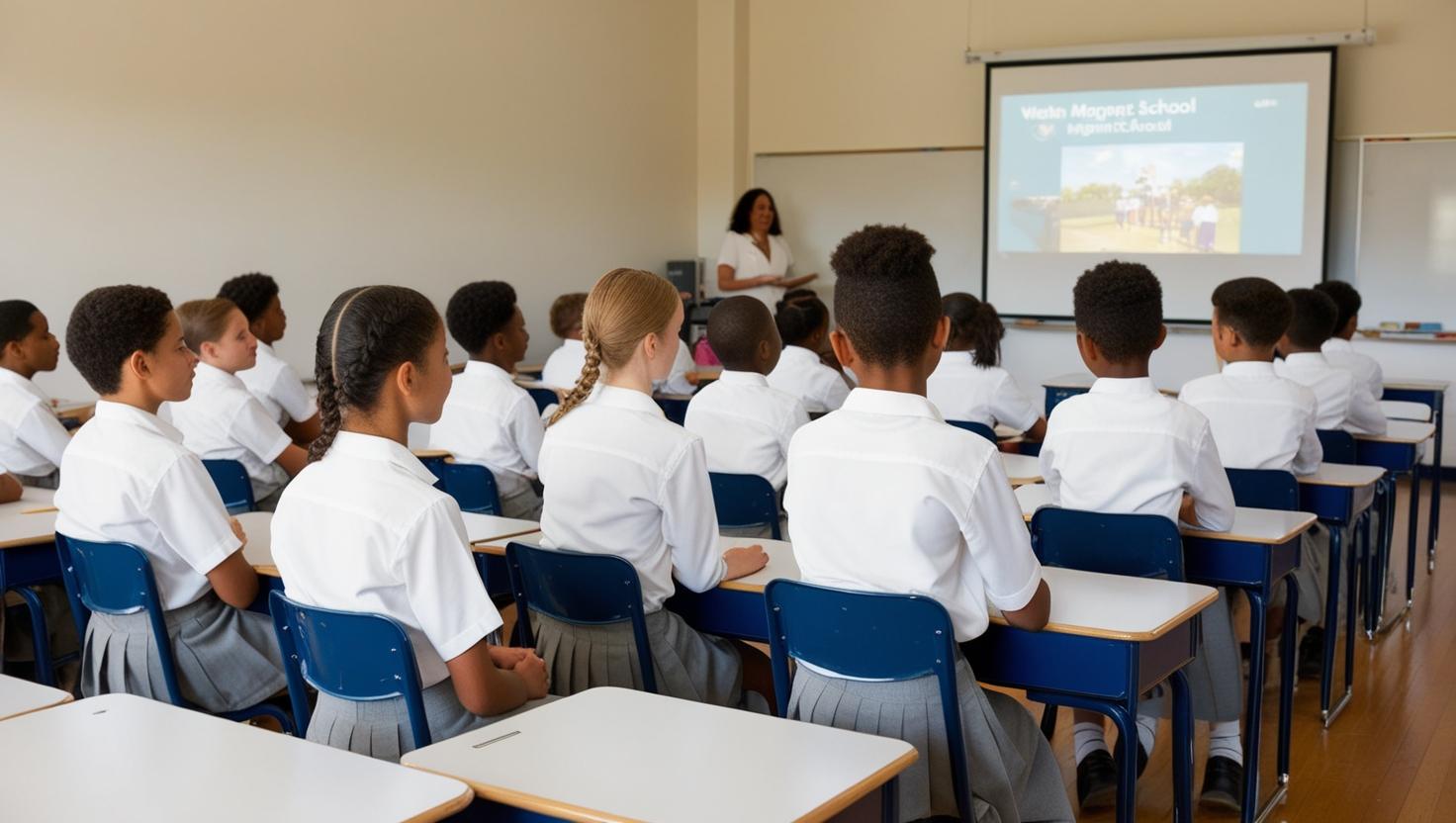What are the Benefits of Magnet Schools?
The quality of your child’s education will have a significant impact on the rest of his life.
- The education he receives while he is young will prepare him for higher education and, eventually, a career.
- The challenge is, however, that there are many different types of schools to choose from.
- If you want your child to receive the best education available to him, consider enrolling him in a magnet school.
Canva generated this picture of a class in a magnet school.

What is a Magnet School?
A magnet school is a type of public school that, while still part of the local public school system, has a particular curricular focus.
- In many ways, magnet schools are just another type of school but there are some key features that set these schools apart.
- In the United States, magnet schools are developed around a core set of five principles according to the Magnet Schools of America organization.
These five pillars include the following things:
- Diversity – Part of what sets magnet schools apart from other schools is the focus on diversity which gives students a global educational experience. Through recruitment and lottery systems, magnet schools strive to develop a student body that is reflective of the surrounding community.
- Innovative Curriculum and Professional Development – Each magnet school has a particular theme and the curriculum is relevant to that theme, designed to prepare students for higher education and eventual career success.
- Academic Excellence – Magnet schools are committed to multi-dimensional instruction which is focused on the needs of the students. Various assessment strategies are used to monitor student progress and learning while high expectations are clearly articulated and upheld.
- High-Quality Instructional Systems – Magnet school instruction is rooted in well-educated and well-prepared professional educators. The teachers and staff are collaborative and student-centered.
- Family and Community Partnerships – These partnerships offer students a system of support all while promoting the integrated theme-based educational environment.
This video describes how magnet schools came into existence, as well as how magnet schools benefit students.
Not only do magnet schools follow these five principles, but they also adhere to certain themes.
- One of the most common themes for magnet schools is STEM – Science, Technology, Engineering, and Math.
- Magnet schools can also focus on various vocational or career paths, certain languages, and even the arts.
- Though magnet schools often have this kind of curricular focus, they still offer a comprehensive education.
- What really sets these schools apart, however, is the fact that students are enrolled by choice, not simply by where they live. T
- his gives children who live in poorer neighborhoods an opportunity to receive a quality education.
The Pros and Cons of Magnet Schools
The first of the five pillars of magnet schools is diversity and that is also one of the greatest benefits associated with magnet schools.
- By using a lottery system and various recruitment strategies, magnet schools develop a diverse student population.
- Magnet schools allow children to enroll in schools outside of the school zone where they live – not only does this enhance diversity, but it also helps to desegregate the public school system.
- Students who attend magnet schools have the opportunity to learn alongside children from a wide variety of backgrounds and cultures.
- They also have the chance to make friends with other children from all over their city, not just in their neighborhood.
This video describes magnet schools as another public school option.
In addition to providing children with a more diverse learning experience, magnet schools also allow students to focus on the subjects they find most interesting.
- Each magnet school has a particular curricular focus in addition to teaching general education subjects.
- Gifted students do particularly well in magnet schools because education is catered to their interests and to their ability to learn.
- Traditional public schools sometimes smother gifted children by forcing them to learn at the same pace as students who are less academically gifted or by limiting their ability to explore the subjects in which they are particularly interested.
While the theme-based educational style employed by magnet schools can be a benefit in many ways, it can sometimes become a problem if the curriculum becomes too narrow.
For students who already have a developed interest or skills in a particular area, magnet schools can be great. For students who have not yet decided on a career path, however, such a narrow curriculum could stunt their academic growth.
- Though the academic benefits of magnet schools are many, there are some trade-offs you have to think about.
- For example, sending your child to a magnet school may require a longer commute, depending on where you live – it is not uncommon for magnet school students to sit on a bus for an hour to and from school each day.
- Sending your child to a magnet school may also separate him from the friends he has already made in his neighborhood and in his current school.
- There will be plenty of opportunities to make new friends. Still, it can sometimes be difficult for magnet school students to maintain friendships outside of school since the student population comes from all over the city.
The Top 5 Magnet Schools in America
Each magnet school is unique in terms of the diversity of the student body and the curricular focus. To help you learn more about what magnet schools are like and how they work, consider the top five magnet schools in America as reviewed below:
- School for the Talented and Gifted (Dallas, TX) – This school is focused on the Advanced Placement curriculum, requiring a minimum of 11 AP courses for graduation. Students are also given opportunities to conduct field research in the form of partnerships with local universities, elective mini-courses, and other career-based learning modules. This school enrolls fewer than 250 students each year, offering a 15:1 student-teacher ratio and a 100% graduation rate.
- Academic Magnet School (North Charleston, NC) – This school seeks to “challenge each student, teacher, and parent with high academic expectations by offering a selection of honors or AP courses. Each student is also required to complete a year-long independent research project. This school enrolls about 600 students each year, offering a 14:1 student-teacher ratio and a 100% graduation rate.
- Carnegie Vanguard High School (Houston, TX) – This school is focused on a curriculum of pre-AP and AP courses as well as various honors electives. Each student has required a minimum of 7 AP courses in order to graduate and there is a strong emphasis on community involvement – each student must complete 100 hours of community service to graduate. This school enrolls about 600 students each year, offering a 17:1 student-teacher ratio and a 100% graduation rate.
- International Academy of Macomb (Clinton Township, MI) – This school offers students the opportunity to take International Baccalaureate coursework and exams. This school enrolls about 450 students each year, offering education in grades 9 through 12 with a 100% graduation rate.
- Design and Architecture Senior High (Miami, FL) – This magnet school places a focus on fashion, fine art, communication, entertainment, architecture, and industrial design with its curriculum. Students are allowed to select courses to combine with their general education with a variety of honors and AP options available. This school enrolls about 500 students each year, offering a 16:1 student-teacher ratio and a 100% graduation rate.
If you think that a magnet school might be the right choice for your child, take the time to learn about the application and enrollment process. The process for applying to magnet schools can be lengthy at times, so be sure that it is the best option for your child before you begin. Your child’s application will be evaluated based on his standardized test scores and other academic criteria, of course. Still, additional factors like availability and percentage set-asides will also come into play. If you really want to secure your child’s spot, you may need to go so far as to move to another school zone to increase his chances for admission.
Listen to the Deep Dive podcast version of this article.
Questions? Contact us on Facebook. @publicschoolreview
#MagnetSchools #EducationOptions #SchoolChoice #STEM #AcademicExcellence #PublicEducation #DiverseLearning #GiftedEducation















